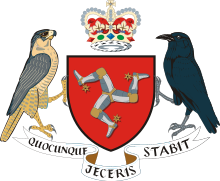Coat of arms of the Isle of Man
| The Arms of Her Majesty in right of the Isle of Man | |
|---|---|
 |
|
| Details | |
| Armiger | Elizabeth II, Lord of Mann |
| Adopted | 12 July 1996 |
| Crest | An imperial crown proper |
| Escutcheon | Gules a triskele argent garnished and spurred or |
| Supporters | Dexter a peregrine falcon and sinister a raven both proper |
| Motto | Quocunque Jeceris Stabit |
The Coat of Arms of the Isle of Man dates from 12 July 1996. As the Isle of Man is a Crown dependency, the arms are more accurately described as the Arms of Her Majesty in right of the Isle of Man. The coat of arms—featuring a triskeles—is based upon the traditional coat of arms associated with island which first appears on record in the late thirteenth century. The origin of the triskeles is obscure but appears to stemmed from the Scottish takeover of the island at this point in history. The heraldic supporters are birds associated with the island, whilst the motto first appears on record in the seventeenth century.
The coat of arms was granted by Elizabeth II, Lord of Mann, on 12 July 1996. The escutcheon is blazoned: gules a triskele argent garnished and spurred or. The crest is blazoned: an imperial crown proper. The supporters are blazoned: dexter a peregrine falcon and sinister a raven both proper. The motto is: Quocunque Jeceris Stabit.
The heraldic device of the triskele or triskeles has been associated with the Isle of Man for centuries. The supporters are symbolically associated with the island as well. In 1405, Henry IV, King of England gave the Isle of Man to John Stanley. The latter gave Henry two peregrine falcons, and was required to provide the same to every future English king on his coronation. This formal bestowal of two falcons continued as a late as the coronation of George IV in 1822. The raven is a bird strongly associated with Norse mythology, and appears in numerous place names on the island.
...
Wikipedia
